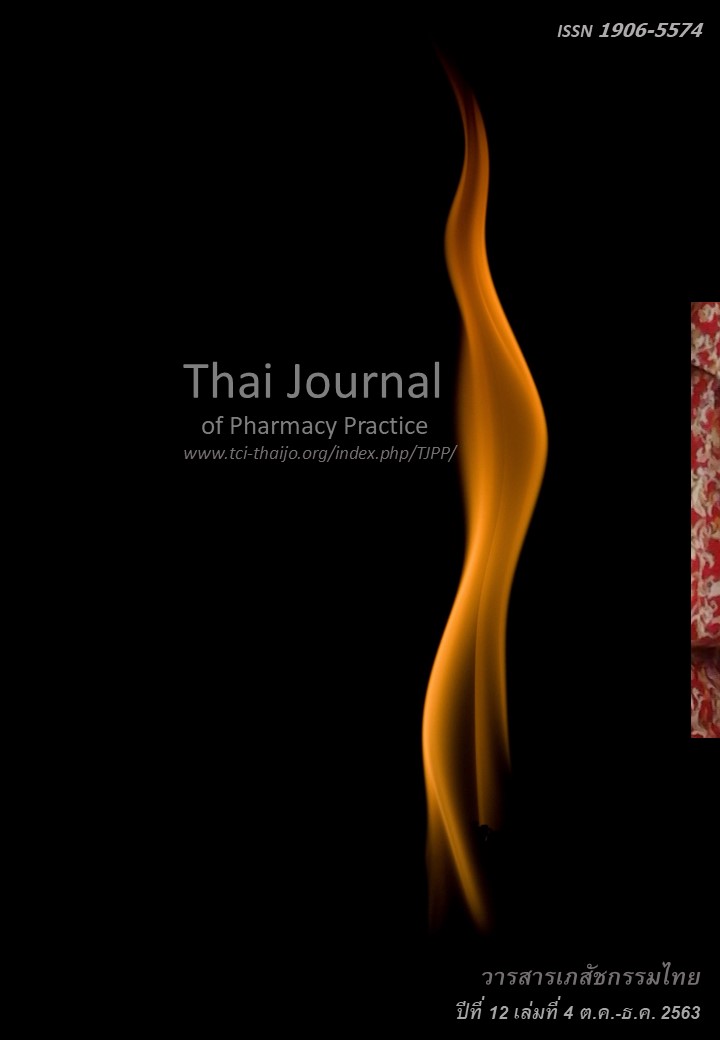ประสิทธิภาพของการให้ความรู้และคำปรึกษาโดยทีมสหสาขาวิชาชีพเพื่อจัดการโรคเบาหวานด้วยตนเอง: กรณีศึกษาในโรงพยาบาลตติยภูมิแห่งหนึ่ง
Main Article Content
บทคัดย่อ
วัตถุประสงค์: เพื่อศึกษาประสิทธิภาพของการให้ความรู้และคำปรึกษาเพื่อจัดการโรคเบาหวานด้วยตนเองโดยทีมสหสาขาวิชาชีพต่อการควบคุมระดับน้ำตาลในเลือด วิธีการ: การวิจัยนี้เป็นการเก็บข้อมูลย้อนหลังจากแฟ้มข้อมูล เกณฑ์การคัดผู้ป่วยเข้าในการศึกษา ได้แก่ 1) ได้รับการวินิจฉัยเป็นเบาหวานชนิดที่ 2, 2) มี fasting blood glucose (FBG) > 300 mg/dL จากผลตรวจวัดครั้งล่าสุด และ FBG > 170 mg/dL ในช่วง 6 เดือนก่อนคัดเข้า หรือ Hemoglobin A1C (HbA1C) ≥ 8% หรือมี estimated glomerular filtration rate stage 3B 3) สามารถสื่อสารด้วยภาษาไทย และ 4) ผู้ป่วยรับบริการจากแผนกผู้ป่วยนอกของโรงพยาบาลตติยภูมิที่ศึกษาระหว่างเดือนกุมภาพันธ์ถึงพฤกษภาคม พ.ศ.2560 กลุ่มทดลองรับความรู้และคำปรึกษาเพื่อจัดการโรคเบาหวานด้วยตนเองแบบเฉพาะรายโดยทีมสหสาขาวิชาชีพ ประกอบด้วย นักสุขศึกษา นักโภชนากร และเภสัชกร กลุ่มควบคุมได้รับการบริการแบบปกติ ผลลัพธ์ที่ศึกษา ได้แก่ ระดับ HbA1C ที่เปลี่ยนแปลง สัดส่วนผู้ป่วยที่มี HbA1C ลดลงมากกว่า 1% ที่สัปดาห์ 24 หลังเริ่มการศึกษา และภาวะแทรกซ้อนที่เกิดขึ้นระหว่างการศึกษา พฤติกรรมการควบคุมอาหาร เครื่องดื่มกาแฟ และความร่วมมือในการใช้ยา ผลการวิจัย: ตัวอย่างทั้งหมด 106 ราย แบ่งเป็นกลุ่มควบคุม 48 ราย และกลุ่มทดลอง 58 ราย กลุ่มควบคุมมีระดับ HbA1C ลดลง 0.67 ± 2.19 mg% ส่วนกลุ่มทดลอง HbA1C ลดลง คือ 1.02 ± 1.58% ทั้งนี้ไม่มีความแตกต่างกันอย่างนัยสำคัญทางสถิติ (P=0.353) เมื่อวิเคราะห์ด้วยการวิเคราะห์ถดถอยพหุคูณซึ่งปรับด้วยคะแนนความโน้มเอียง (propensity score) พบว่า กลุ่มทดลองสามารถลดค่า HbA1C ได้มากกว่ากลุ่มควบคุม (-0.20 % (95% confidence interval; -0.10 ถึง 0.59%) แต่ไม่มีนัยสำคัญทางสถิติ สำหรับสัดส่วนของผู้ป่วยที่ HbA1C ลดลง ≥ 1.0% ที่สัปดาห์ 24 ในกลุ่มทดลองและกลุ่มควบคุมมีสัดส่วนที่ใกล้เคียงกัน (ร้อยละ 41.30 และ 39.58; P=0.851) ภาวะแทรกซ้อนที่เกิดขึ้นระหว่างการศึกษาในกลุ่มควบคุม คือ ภาวะน้ำตาลในเลือดสูงหรือกรดคีโตนคั่ง (ร้อยละ 14.58) ในขณะที่ไม่พบภาวะแทรกซ้อนดังกล่าวในกลุ่มทดลอง กลุ่มทดลองมีปริมาณการบริโภคคาร์โบไฮเดรต และปริมาณการดื่มกาแฟลดลง และร้อยละความร่วมมือในการใช้ยาเพิ่มขึ้นเมื่อเปรียบเทียบกับก่อนเข้าคลินิกอย่างมีนัยสำคัญทางสถิติ (P<0.05) สรุป: การให้ความรู้และคำปรึกษาเพื่อจัดการโรคเบาหวานด้วยตนเองโดยทีมสหสาขาวิชาชีพมีประสิทธิภาพในการลดระดับน้ำตาลในเลือดมากกว่ากลุ่มควบคุม แต่ไม่มีความแตกต่างอย่างไม่มีนัยสำคัญทางสถิติ อย่างไรก็ตาม พบแนวโน้มในการลดภาวะแทรกซ้อนเฉียบพลัน และการปรับเปลี่ยนพฤติกรรมของผู้ป่วยเบาหวานเพื่อจัดการตนเองในด้านการควบคุมอาหารและความร่วมมือในการใช้ยาที่ดีขึ้น
Article Details
ผลการวิจัยและความคิดเห็นที่ปรากฏในบทความถือเป็นความคิดเห็นและอยู่ในความรับผิดชอบของผู้นิพนธ์ มิใช่ความเห็นหรือความรับผิดชอบของกองบรรณาธิการ หรือคณะเภสัชศาสตร์ มหาวิทยาลัยสงขลานครินทร์ ทั้งนี้ไม่รวมความผิดพลาดอันเกิดจากการพิมพ์ บทความที่ได้รับการเผยแพร่โดยวารสารเภสัชกรรมไทยถือเป็นสิทธิ์ของวารสารฯ
เอกสารอ้างอิง
International Diabetes Federation. IDF diabetes atlas, 7th edition [online]. 2015 [cited Aug 10, 2016]. Available from: www.dmtahi.org/sites/defau lt/files/idf_atlas_2015uk_9.pdf
World Health Organization Global report on diabetes [online]. 2016 [cited Sep 13, 2016]. Available from: apps.who.int/iris/bitstream/handle/10665/204871/9789241565257_eng.pdf
Suksa-ad T, Ngamarun W, Suriwongphaisan W. NCD disease report no.2 “kick off the goals” [online]. 2016 [cited Aug 2, 2017]. Available from: www.dmthai.org/sites/default/files/ncd_nhes_v_2016.pdf
Strategy and Planing Division, Bureau of Non Communicable Diseases, Department of Disease Control. National non-communicable disease and control plan 5 years 2017 -2021 [online]. 2017 [cited Aug 7, 2019]. Available from: www.searo.wh o.int/thailand/areas/national-ncd-prevention-and-co ntrol-plan-2017-2021-tha.pdf
Siangdung S. Sef-care behaviors of patients with uncontrolled DM. The Southern College Network Journal of Nursing and Public Heatlh. 2017; 4:191-204.
Akhawathin L, Maranon S, Khattiya S. Health behavior of diabetic patients: a case study of patients at tambon muangngam, amphur sao hai, Saraburi province. Journal of Graduate Studies Valaya Alongkorn Rajabhat University. 2011; 5: 103-12.
Diabetes Association of Thailand. Clinical practice guideline for diabetes 2017. Bangkok. Romyen media; 2017.
Sanee A. Self management program in chronic disease. Journal of the Royal Thai Army Nurses. 2014; 15: 129-34.
Service System Development Strategy. Region 6 health provider 2015-2017.[online]. 2017. [cited Oct 15, 2017]. Availaible from: region6. cbo.moph. go.th/yuttha.pdf
Rosner B. Fundamentals of biostatistic. 7th ed. Boston: Nelson Education; 2000.
Khumrungsee M, Methakanjanasak N. The effects of self-management program on blood sugar control and quality of life among newly diagnosed type 2 diabetes mellitus patients. Journal of Sakon Nakhon Hospital. 2013; 16:43-54.
Mongkolsomlit S, Homkham N. Propensity socre analysis in health science research. Vajira Medical Journal 2018; 62: 33-42.
Beal SJ, Kupzyk KA. An introduction to propensity score: what, when and how. J. Early Adolesc. 2014; 34: 66-92.
Charoensuk K. Propensity score analysis: principle and concept. Thai Journal of Hepatology 2018; 1: 25-7.
Cook C E. Clinimetrics corner: the minimal clinic- ally important change score (MCID): a necessary pretense. J Man Manip Ther 2008; 16: E82-3.
Karyekar CS, Frederich R, Ravichandran S. Clinic ally relevant reduction in HbA1C without hypogly cemia: results across four studies of saxagliptin. Int J Clin Pract. 2013;67:759-67.
Umbangthalud D, Prasongwattana S. Effectiveness of intensive care program for patients with type II diabetes on knowledge, self-management behavior and blood glucose levels of diabetic patients in the PCU, Bang Pa-In district, Pra Nakhon Si Ayutthaya province. Nursing Public Health and Education Journal. 2017; 18; 11-23.
Ovatakanont P, Sunthara W. Outcomes of group education program for type 2 diabetic patients in Saimun hospital. Srinagarind Medcal Journal 2012 ; 27: 235-41.
Sinprasit S, Panwong S. The impact of patient care team’s intervention in diabetic clinic: a case study of Kabcheong hospital. Thai Pharmaceutical and Healht Science Journal. 2008; 3: 67-72.
Muankum A, Suttajit S. Effects of patient empower ment on self-efficacy, adherence and glycemic control in patients with type 2 diabetes. Thai Pharmaceutical and Healht Science Journal 2013; 8: 104-11.
Boonploy V, Manit A. Effects of nurse case manager and multidisciplinary clinical pathway for type 2 diabetic patients, Lop Buri hsopital. Journal of Health Science. 2009; 18: 404-13.
Songmuang A, Songmuang T, Jampasa N. Outcome of diabetic patient management by proactive pharmaceutical care service. Srinagarind Medical Journal 2017; 32: 236-43.
Wichit N, Mnatzaganian G, Courtney M, Schulz P, Johnson M. Randomized controlled trial of a family-oriented self-management program to improve self-efficacy, glycemic control and quality of life among Thai individuals with type 2 diabetes. Diabetes Res Clin Pract. 2016; 23: 37-48.
Yaemphaka B. Effects of drug counseling on correct used and adherence in insulin injection for patients in diabetes clinic at Pongnamron hospital, Chanthaburi province. Journal of Government Pharmaceutical Organization. 2015; 41: 19-24.
Panacek E A. Performing chart review studies. Air Medical Journal. 2007; 5: 206-10.
Hess D R. Retrospective studies and chart review. Respir care. 2004; 49: 1171-4.
Vassar M, Holzmann M. The retrospective chart review: important methodological considerations. J Educ Eval Health Prof. 2013; 10: 1-7.


